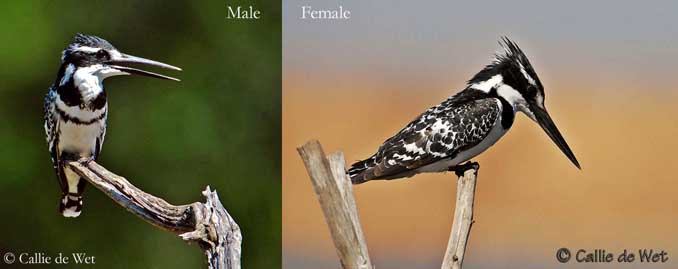
Pied Kingfisher
Ceryle rudis
Coraciiforme Order - Alcedinidae family
BIOMETRICS :
Length: 24-26 cm; Wingspan: 45-47 cm; Weight: 70-95 g
LONGEVITE: up to 4 years
DESCRIPTION:
Pied Kingfisher has black and white plumage. It is impossible to confuse this medium-sized bird with other kingfisher.
Male has black crest and crown, white stripe above the eye, black larger stripe across the eye extending on nape, and white throat and collar. Upperparts are black with white edges giving a mottled aspect. Rump is streaked black and white.
We can see white spots on the wing coverts. Underparts are white, finely barred with two black lines, the higher being broader and often broken in the middle.
Bill is black, long and similar to a dagger. Eyes are dark brown. Legs and feet are blackish.
Female has only one breast band, narrower than male and also broken in the middle.

Young resembles female, but it has complete breast band, rather greyish- black than black. It has some blackish "scales" on the white areas, and on head, neck and throat.
In flight, the fanned tail is rather long, white, with black median tail feathers and tips.
Hand is black, with broad white spot at primary base.
VOICE: SOUNDS BY XENO-CANTO
Pied Kingfisher’s typical call is a loud, penetrating and repeated "kwik" or "kik", and a high-pitched “TREEtiti TREEtiti ".

HABITAT:
Pied Kingfisher lives close to the water, near large rivers, in estuaries, near small and large lakes, coastal lagoons, on rocky and sandy coasts, close to fresh or brackish water tanks. It needs perches close to water, as trees, fences, posts and others.
RANGE:
Centre and South of Turkey, Israel to Syria, Iraq, SW Iran, northern Egypt and Nile Valley, south of the Sahara.
BEHAVIOUR:
Studies show that Pied Kingfisher has complex behaviour. As in many tropical birds, breeding pair has several non breeding birds as helpers, up to four. They sometimes are the young of the previous year, but they may are completely exterior to the pair family. This system makes it possible to raise the greatest number of young within the colony, in spite of the environment. It nests alone or in colonies, usually less of 20 nests.

It fishes by watching for preys from a perch, bobbing head and flicking tail, and then by diving into the water making shower of water, and appearing again with its stabbed prey in the bill. It also may hover before to dive, just time to locate prey.
When back on its perch, it strikes the prey against the support in order to stun it, then, it returns it before to swallow.
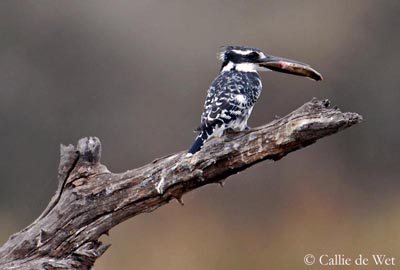
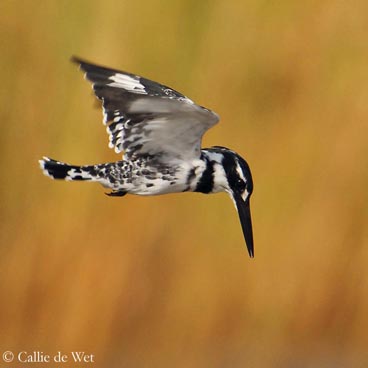
Pied Kingfisher is usually sedentary. Seasonal dispersions are abundant, but it is mainly according to the food resources, rather regular migrations.
FLIGHT:
Pied Kingfisher hovers when searching for prey above water. This behaviour allows hunting over large water surfaces, being the only kingfisher able to move away from the shores. Usually, it performs a rather slow flight, often high above the water, before diving to catch its prey.
REPRODUCTION:
Pied Kingfisher’s nest is dug in an earthy bank, above water, occasionally in a flat and grassy ground. Pair digs the burrow which sizes about one metre in depth.
Female lays 4 to 5 white glossy eggs. Incubation lasts about 18 days, shared by both adults. During nest’s digging, laying and incubation, the male displays and feeds the female. It also takes part in raising chicks before they fledge. Young remain at nest about three weeks.
They reach their sexual maturity at one year.

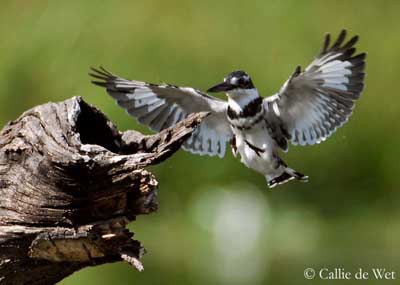
DIET:
Pied Kingfisher feeds mainly on fish, aquatic insects, crabs and crayfish, frogs and molluscs.
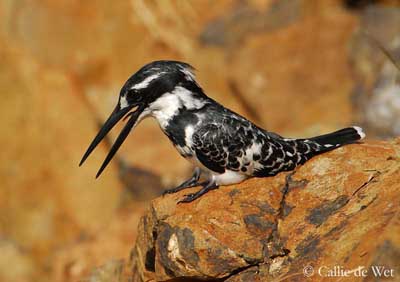
PROTECTION/ THREATS/ STATUS:
Pied Kingfisher populations are not threatened. Pied Kingfisher is one of the Kingfishers the most widespread in the world.
Fr: Alcyon pie
All : Graufischer
Esp : Martín Pescador Pío
Ital: Martin pescatore bianco e nero
Nd: Bonte Ijsvogel
Russe: Малый пегий зимородок
Sd: Gråfiskare
Photographs by Callie de Wet
GALLERY
Text by Nicole Bouglouan
Sources:
HANDBOOK OF THE BIRDS OF THE WORLD Vol 6 by Josep del Hoyo-Andrew Elliott-Jordi Sargatal - Lynx Edicions, 2001 - ISBN: 848733430X
BIRDS OF AFRICA SOUTH OF THE SAHARA by Ian Sinclair and Peter Ryan - Princeton University Press Princeton and Oxford - ISBN: 0691118159
Wikipedia (Wikipedia, The Free Encyclopedia)
Animal Diversity Web (University of Michigan Museum of Zoology)